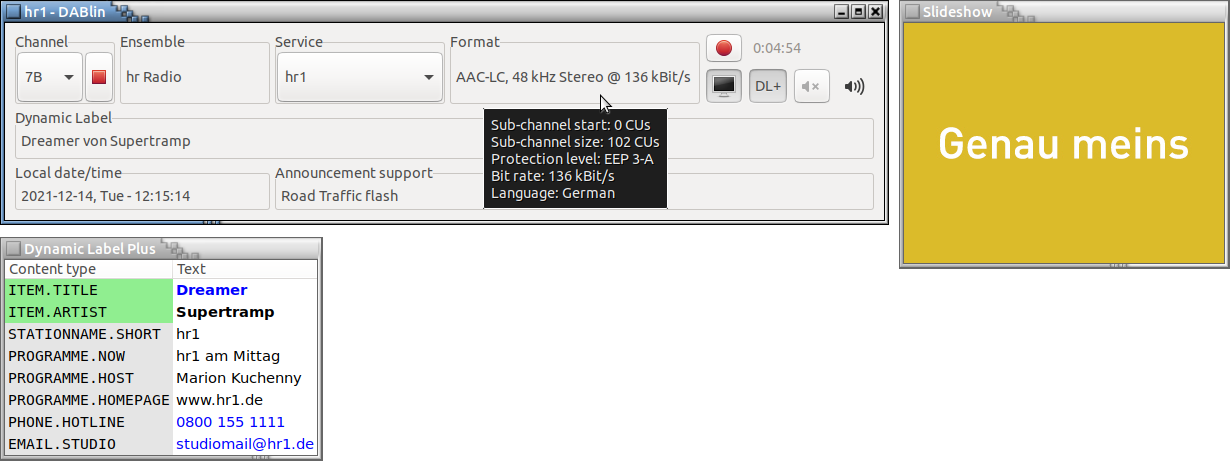DABlin plays a DAB/DAB+ audio service - either from a received live transmission or from a stored ensemble recording (frame-aligned ETI-NI). Both DAB (MP2) and DAB+ (AAC-LC, HE-AAC, HE-AAC v2) services are supported.
A recent GCC (with C++11 support) and GNU Make are required. Furthermore CMake, if used for compilation (see below).
The following libraries are needed in addition:
- ka9q-fec (tested with https://github.com/Opendigitalradio/ka9q-fec)
- mpg123
- FAAD2
- SDL2
On e.g. Ubuntu 14.04 you can install them (except ka9q-fec) via:
sudo apt-get install libmpg123-dev libfaad-dev libsdl2-dev
For the GTK GUI, you furthermore need:
- gtkmm
Package installation on e.g. Ubuntu 14.04:
sudo apt-get install libgtkmm-3.0-dev
Instead using FAAD2, DAB+ channels can be decoded with FDK-AAC. You can also use the modified version fdk-aac-dabplus of OpenDigitalradio itself, if already installed.
After installing the lib, you have to:
- enable the regarding line in
Makefile(when using Make) - insert
-D USE_FDK-AAC=1after thecmakecall (when using CMake)
To compile DABlin, just type make. If you only want to compile the
console or the GTK version, you can use make dablin and/or
make dablin_gtk.
You can use e.g. the following command sequence in order to compile DABlin:
mkdir build
cd build
cmake ..
make
The console version will be built in any case while the GTK GUI is built
only if gtkmm is available.
You can either use the console version dablin or the GTK GUI version
dablin_gtk.
DABlin processes frame-aligned DAB ETI-NI recordings. If no filename is
specified, stdin is used for input.
You just have to specify the regarding Service ID (SID). The GUI version
does not necessarily need this - in that case initially no service is
played until one is chosen.
If you want to play a live station, you can use dab2eti from dabtools
and transfer the ETI live stream via pipe, e.g.:
dab2eti 216928000 | dablin_gtk
You can also replay an existing ETI-NI recording, e.g.:
dablin -s 0xd911 mux.eti
It is possible to let DABlin invoke dab2eti. You therefore just have
to specify the path to the dab2eti binary and the desired channel.
dablin -d ~/bin/dab2eti -c 11D -s 0xd911
In case of the GTK version the desired channel may not be specified. To avoid the huge channel list containing all possible DAB channels, one can also state the desired channels (separated by comma) which shall be displayed within the channel list.
dablin_gtk -d ~/bin/dab2eti -c 11D -C 5C,7B,11A,11C,11D -s 0xd911
Using dab2eti the E4000 tuner is recommended as auto gain is supported
with it.
During (re-)synchronisation status messages are output. Also dropped Superframes or AU are mentioned.
If the Reed Solomon FEC was used to correct bytes of a Superframe, this
is mentioned by messages of the format (3+). This shorter format is
used as those messages occure several times with borderline reception.
The digit refers to the number of corrected bytes within the Superframe
while a plus (if present) indicates that at least one byte was
incorrectable.
At the moment, DABlin is kind of a rudimentary tool for the playback of DAB/DAB+ services. It is planned to add support for further Program Aided Data (PAD) like MOT Slideshow et cetera.
(please see the file COPYING for further details)
DABlin - capital DAB experience Copyright (C) 2015 Stefan Pöschel
This program is free software: you can redistribute it and/or modify it under the terms of the GNU General Public License as published by the Free Software Foundation, either version 3 of the License, or (at your option) any later version.
This program is distributed in the hope that it will be useful, but WITHOUT ANY WARRANTY; without even the implied warranty of MERCHANTABILITY or FITNESS FOR A PARTICULAR PURPOSE. See the GNU General Public License for more details.
You should have received a copy of the GNU General Public License along with this program. If not, see http://www.gnu.org/licenses/.
